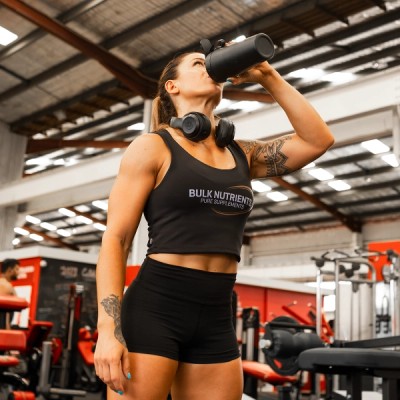
A New Year's resolution gym-goers guide to the gym
Posted by Dayne Hudson
Estimated reading time: 6 minutes

Across Australia, gym closures have resulted in a substantial decrease in training volume for most people. Whether your training during this time has been cut to barbell exercises, a few accessories, bodyweight exercises, squats with your dog or sitting on the couch, you’ll need to plan your return to the gym. If you were to go back to your normal training workload (with the same volume and intensity) you may be setting yourself up for an injury!
While there are many risk factors for injury, training-load related injuries are among the most preventable and knowing your Acute:Chronic Workload Ratio is the key to bouncing back from your gym break. Let’s get started...
With isolation, you have a decreased training load and likely decreased activity overall. Your body is not prepared to hit your 1RM after this. Being out of practice increases your risk of load-related injuries as your joints, muscles, and tendons are not primed for the weight. Rushing the process could also leave you at risk of form-related injuries if you have been training different movements or with different equipment. We also have a second blog on returning to the gym and muscle memory.

The Acute : Chronic Workload Ratio or ACWR, is one common tool used to monitor training loads for a variety of athletes in different sports. The ratio measurements are used to plan training, modify training, and prevent the risk of injury. The ACWR is a popular method due to its ease of use and versatility. Put simply, it is a measure of your fatigue versus your fitness.
Your “acute workload” or “fatigue” is a calculation of the workload you completed in one week.
Your “chronic workload” or “fitness” is a calculation of the average of a four-week period of your workload. This means your workload is calculated and then averaged out for the four-week period.
Put simply The Acute:Chronic Workload Ratio is determined by dividing the acute workload (fatigue) by the chronic workload (fitness)*.
The ideal ACWR will vary depending on the individual and various factors that affect training, but studies on the ACWR show trends in the data which indicate that an ACWR of 0.8 or less is too low to drive progress (undertraining), and ACWR of 0.8—1.5 is the optimal load while managing injury risk, and an ACWR over 1.5 increases risk of injury and should be avoided (overtraining).
To work out your ACWR and plan your training, all you need is your last four weeks of training and the calculator on your phone...
1. Find out what your chronic load is
Multiply the number of reps x weight x sets for each exercise you completed in each training session. If you did 3 sets of 5 reps with 40 kilos, your workload for that workout is 3x5x40 or 600.
Do this for each training session in the last four weeks and add these to calculate your total tonnage. Divide your four-week total tonnage by four to get your chronic workload.
For example:
Jane has been training for powerlifting. She was able to borrow a few pieces of equipment from her coach’s home set-up when the lockdown was looming. During the lockdown, she has been completing barbell exercises up to a maximum of 55kg and little accessory work. When gyms reopen, she will be returning to her coach’s full set-up. We will calculate her load by tonnage.
If we look at her deadlift volume over the last four weeks, she has an average load of 1267.5kg. This is calculated by adding the last four weeks of volume: 3x10x40 + 3x10x45 + 3x8x50 + 3x8x55 = 5070kg and then dividing by 4 which gives us 1267.5kg.

2. Decide how hard you want to go when you start training again
An ACWR of 1 to 1.3 would be ideal to reintroduce you to the gym if you’ve kept active but have decreased load. If you haven’t exercised, consider .8 – 1. If you have stayed relatively unscathed then depending on your taste 1 – 1.5 can be appropriate.
3. Figure out your new training load
You can work out your ideal starting load by multiplying your desired ACWR by your chronic workload.
For example, Jane has selected a 1.2 ACWR to progress her training while staying safe. If we multiply her chronic workload by her desired 1.2 ACWR we get 1267.5x1.2 = 1521.7kg workload.
A suitable loading scheme for Jane would be 3 sets of 6 reps so now we solve for the unknown (weight). Does this feel like high school math class yet?
Our equation is 3 x 6 x weight = 1521.7kg
So, weight = 1522 / 3 x 6
= 1522 / 18
= 84.55kg
Solving for the unknown (weight) means Jane can achieve her desired ACWR with 3 sets of 6 reps at 84kg. She has easily done this weight in the past and will be progressing at a safe rate.
Players in team sports such as rugby have also seen a drop in training load. For some, the entire pre-season and the bulk of their fitness work have been dropped. If this is you, read on to find out how to return to full training based on what you have been doing during the lockdown.
1. Work out your chronic load
For this example, we are going to use the total km covered in training sessions. This is usually calculated by your watch. As an alternative, you could calculate your average heart rate x minutes of training if you prefer your heart rate monitor.
For example:
John has been training by himself since lockdown. He completes drills and running at home or around his neighbourhood. Over the past four weeks, John has done a long run twice a week of 8km, an interval run once a week totalling 4.5km and drills twice a week totalling 2km each. His average workload over the last four weeks is 24.5km.
2. Choose how hard you want to push
John is feeling good about his return to sport and is keen to push to a 1.3 ACWR. If we multiply John’s chronic workload by 1.3 we will get his acute workload goal.
3. Determine your new load for training
24.5 x 1.3 = 31.85km
John can divide this workload in a similar format to his chronic workload. He wants to keep his 2x long runs to do by himself but add to his interval and drill training which he will do with teammates. John can achieve 31.85km through a 2x 8km long run, 1x 6km interval run, and 2x drill sessions of just under 5km.

Yes, acute and chronic workloads can be measured in a variety of ways for any sport or physical activity based on external load, internal load or a combination of both. An example of your external load would be a weight lifted in tonnage or total kilometres run. An example of your internal load would be heart rate or RPE multiplied by minutes of training. You can choose any method that best suits your training, then keep it consistent throughout your calculations.
If you’re still feeling unsure about how to return to the gym safely, now is the time to reach out to your coach or practitioner. If you do not yet have a coach or practitioner, reach out to the one you trust. You want to look for someone who is bachelor qualified and has experience in rehabilitation and managing injury risk. Be open and honest about your current situation, what you want to get out of the coach- or practitioner-athlete relationship, and what your long-term goals are.
General injury prevention guidelines should still be followed during this time. These include being prepared for training, completing your full warm-up and using all necessary equipment, ensuring you have adequate nutrition and hydration on training and rest days, and prioritising optimal sleep and rest.
*These periods of time and workload calculations can be changed depending on the situation. It is common for a four-week period to be used so that’s what we will focus on in this blog.

Posted by Dayne Hudson
Estimated reading time: 6 minutes

Posted by Bulk Nutrients
Estimated reading time: 5 minutes

Posted by Ellie Hearn
Estimated reading time: 5 minutes
With over 700 recipes and articles, the Bulk Nutrients Blog has something for everyone! Find a new workout, meet our ambassadors or take a deep dive into our products today.
We're an Australian manufacturer and supplier of high quality sports supplements.
Operating since 2008, Bulk Nutrients has become one of the premier Australian brands to supply nutritional products to top level athletes, competitors and those on a journey to a healthier lifestyle.
One thing that sets Bulk Nutrients apart is that we love to talk to our customers!
Whether you need product advice, help with the website or need a change made to your order... call us on +61 3 6266 4725.
If you prefer email you can email us day or night at info@bulknutrients.com.au
For online chat, hit the 'Chat' button in the bottom right hand corner of your screen and you'll be connected to one of our lovely customer service team.
Or if you'd like to get in touch through our online contact form, that's cool too!
Terms & ConditionsSustainability StrategyPrivacy PolicyPayment InformationSitemap
All prices are in Australian dollars (AUD) and include GST unless otherwise stated.
All content copyright © Bulk Nutrients 2008 - 2024